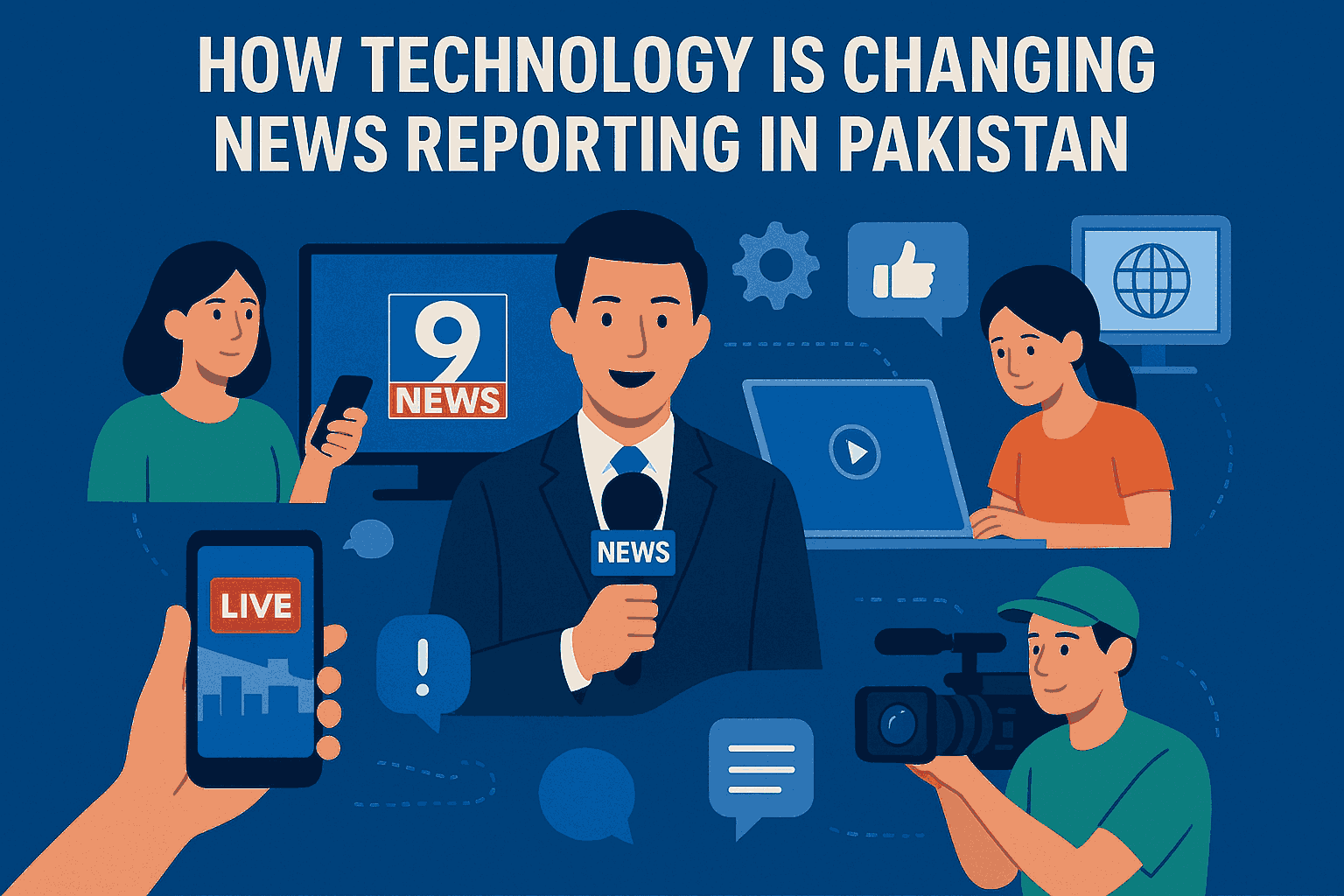How Technology Is Changing News Reporting in Pakistan
By Sana KhalilPublished On 01 Oct 2025

The world of journalism is undergoing a massive transformation, and Pakistan is no exception. From live reporting on mobile phones to the integration of Artificial Intelligence (AI) in newsrooms, technology is reshaping how stories are gathered, produced, and shared with audiences. The traditional boundaries of media have blurred, giving rise to a digital-first environment that thrives on speed, accuracy, and engagement.
In this article, we explore how technology has revolutionized the Pakistani news industry, the tools driving this change, and what the future holds for media professionals and audiences alike.
The Evolution of News in Pakistan
News reporting in Pakistan has evolved significantly over the past two decades. In the early 2000s, television channels like Geo News, ARY News, and 9 News HD began to dominate the media landscape. At that time, the focus was on breaking stories through traditional means — reporters on the ground, camera crews, and newsrooms filled with producers working around the clock.
However, the rise of the internet, smartphones, and social media platforms has dramatically changed how people consume information. Today, Pakistan’s audience is more connected than ever before. According to recent statistics, over 87 million Pakistanis have access to the internet, and a large portion of them rely on mobile phones as their primary source for news updates.
This shift has forced media organizations to adopt digital tools and rethink their approach to storytelling — from conventional TV bulletins to online platforms, live streaming, and real-time social media updates.
The Rise of Digital News Platforms
Digital news platforms have become the backbone of modern journalism in Pakistan. Channels like 9 News HD have expanded beyond television broadcasting to reach audiences through websites, YouTube, Facebook, and X (formerly Twitter).
The digital space allows newsrooms to:
- Deliver breaking news instantly.
- Engage audiences through comments, polls, and live sessions.
- Experiment with multimedia storytelling — integrating text, video, and graphics.
For example, during major political events or natural disasters, news organizations no longer wait for the top-of-the-hour bulletin. They publish updates in real time through push notifications, short clips, and social media posts.
The result? A faster, more dynamic form of journalism that prioritizes accessibility and audience engagement over traditional broadcast limitations.
The Role of Smartphones and Citizen Journalism
Smartphones have arguably made the biggest impact on news reporting in Pakistan. Today, almost every journalist carries a mobile phone equipped with a high-quality camera, editing apps, and live-streaming tools. This mobility allows for on-the-go reporting, especially from remote or high-risk areas where deploying a full camera crew is not feasible.
Moreover, citizen journalism has emerged as a powerful force. Ordinary citizens can now record incidents, upload them to social media, and have their content picked up by mainstream news outlets. Platforms like Facebook and X have become primary sources for breaking stories, especially in smaller cities and rural regions where traditional media coverage is limited.
While this democratization of news has increased transparency, it also raises questions about accuracy and verification, making fact-checking technology more crucial than ever.
Artificial Intelligence and Automation in Newsrooms
The integration of Artificial Intelligence (AI) is redefining newsroom operations in Pakistan. Many media organizations are using AI tools to analyze data, generate reports, and automate repetitive tasks.
For instance:
- AI-powered analytics help editors understand what type of content performs best online.
- Automated news summaries allow media websites to publish quick updates without human intervention.
- Voice-to-text and transcription software streamline interviews and video editing.
Furthermore, AI-driven journalism enables data visualization and sentiment analysis, giving reporters deeper insights into audience behavior and public opinion.
However, while AI offers efficiency, it also presents ethical challenges. There’s an ongoing debate about whether automation could replace human journalists or compromise the authenticity of storytelling. In Pakistan, most experts agree that technology should enhance journalism, not replace it.
The Influence of Social Media on News Consumption
Social media platforms like Facebook, YouTube, TikTok, and Instagram have become central to how Pakistanis consume news. Younger audiences, especially those aged 18–35, are less likely to watch television and more inclined to scroll through short clips or live updates online.
News organizations have adapted by creating platform-specific content:
- Short, visually engaging clips for TikTok and Instagram Reels.
- Live debates and interviews on Facebook Live.
- Detailed analysis and documentaries for YouTube.
This shift has made news more interactive and audience-driven. Users can comment, share, and even participate in discussions in real time, shaping public discourse in ways never seen before.
However, the downside of this digital revolution is the spread of misinformation and fake news. False information can go viral within minutes, making digital literacy and responsible reporting essential components of modern journalism.
Data Journalism: Turning Numbers into Stories
Another major advancement is data journalism — the use of data visualization, infographics, and analytics to explain complex issues. In Pakistan, data-driven reporting has become increasingly popular for covering elections, economic trends, and health crises like COVID-19.
Through interactive graphics and dashboards, audiences can now explore statistics in a more engaging and understandable way. For instance, instead of reading a long report on inflation, viewers can see charts that show monthly price changes or compare regions.
This approach not only enhances transparency but also builds trust, as audiences can verify facts themselves through credible data sources.
Challenges Facing Tech-Driven Journalism in Pakistan
Despite the progress, several challenges persist in the adoption of technology within Pakistan’s news industry:
- Limited training — Many journalists lack technical skills to use advanced digital tools effectively.
- Cybersecurity threats — News websites and social media accounts are often targeted by hackers.
- Misinformation — The rapid flow of content makes it difficult to filter truth from falsehood.
- Digital divide — While urban audiences enjoy high-speed internet, rural areas still struggle with connectivity.
- Ethical dilemmas — Balancing sensationalism and credibility remains a constant struggle in the race for online views.
Overcoming these barriers requires investment in journalist training, fact-checking initiatives, and cybersecurity infrastructure to ensure the integrity of Pakistan’s media ecosystem.
The Future of News Reporting in Pakistan
Looking ahead, the future of journalism in Pakistan lies in hybrid storytelling — a blend of human insight and technological innovation. Newsrooms will increasingly rely on:
- AI-assisted writing tools for faster publishing.
- Augmented reality (AR) and virtual reality (VR) for immersive news experiences.
- Blockchain technology to verify sources and prevent fake news.
- Data-driven investigative journalism to uncover deeper stories.
As audiences continue to demand instant, accurate, and interactive content, media outlets like 9 News HD must continue adapting to stay ahead. The goal isn’t just to report the news — it’s to create meaningful connections through information that empowers people.
Conclusion
Technology has revolutionized news reporting in Pakistan by making journalism faster, more accessible, and more audience-focused. From AI-powered tools to mobile reporting and social media storytelling, the Pakistani media landscape has entered a new digital age.
However, with innovation comes responsibility. Journalists must uphold ethical standards, verify facts, and use technology wisely to serve the public interest. As digital transformation continues, one thing is clear: the future of Pakistani journalism belongs to those who embrace technology not as a threat, but as an opportunity to tell better, more impactful stories

